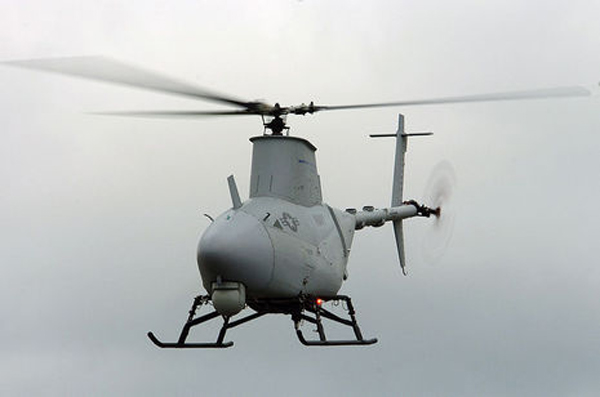Operators of the Navy’s experimental unmanned helicopter were unable to complete a single practice mission at Webster Field in St. Inigoes this year before deploying with the system to Afghanistan, according to a Pentagon report released last month.
The report, leaked last week, was compiled by Michael Gilmore, director of the Pentagon’s Operational Test and Evaluation office for Navy and members of Congress. It states that the MQ-8B Fire Scout’s data link to its ground operators is so fragile that it frequently causes delayed and scratched flights.
“All 10 of the deployment dress rehearsal flights launched at least 14 minutes late,” Gilmore reported. “The average mission experienced a 67-minute launch delay. Once launched, one mission experienced an in-flight abort, and another could not complete all mission tasks because of a data link limitation that required the air vehicle to remain within 10 nautical miles of the ground control station.”
A spokeswoman for the Navy’s Unmanned Aviation and Strike Weapons Programme Office said the report, based on a review between January and March this year, does not reflect changes made by the programme or the vehicle’s performance since its deployment to Afghanistan.
Gilmore reported that operators faced a steep learning curve before deployment. “Operators arrived at the Webster Field [Intelligence, Surveillance, Reconnaissance] Dress Rehearsal as qualified operators based upon classroom and simulator training and two flights conducted at Yuma Proving Ground,” Gilmore wrote in the report issued June 24. They had to be quickly brought up to speed by experienced operators at Webster Field, he reported.
Last August, ground controllers at Webster Field lost contact with one of the aircraft. It wandered into Washington, D.C., civilian airspace and was almost shot down before technicians were able to bring it back home. More recently, a Fire Scout operating under the control of the U.S. Central Command crashed during a covert mission in Libya last month.
Gilmore stated that his report is a preliminary early fielding report. A final operational testing report will be issued next year when the Fire Scout completes operational testing. However, as the system currently works, Gilmore said that helicopter does not meet its stated objective of providing real-time intelligence and targeting information to cruisers and littoral combat ships.
“I conclude the [Fire Scout] may be useful for providing non time-sensitive general area surveillance and intelligence,” Gilmore wrote. “Once on station, the payload provides the commander with a valuable intelligence-gathering asset. However, because of the fragile nature of the data link and difficulties meeting scheduled launch times, supported forces should not depend upon [the Fire Scout] to provide time-sensitive support to ground forces.”
Navy contractors have flown the Fire Scout 1,250 hours and Navy operators have spent 250 hours with it, but Gilmore said those tests “were not operationally realistic, and yielded little insight into the operational effectiveness of the system.” The report cites the vehicle’s start-up process as the source of most of the trouble, noting that the Fire Scout cannot establish a data link with out “excessive troubleshooting and procedural workarounds.”
Gilmore stated, “The tests were conducted in a controlled environment with no opposing forces and at whatever pace was needed to collect required engineering data. No tests were conducted in adverse weather or with any form of electronic combat.” However, even in ideal conditions, the report states, the Fire Scout’s “primary and secondary data links would drop out unexpectedly, necessitating the re-establishment of the link or a mission abort.”
During this year’s deployment on the USS Halyburton, the report states, the Fire Scout successfully completed 29 of its 58 assigned missions. “The poor reliability of the ground control station and the tactical common data link hindered the operators’ ability to launch as scheduled,” the report states. “Once launched, nine missions encountered in-flight aborting failures, and 10 failed to complete all assigned tasks.”
And then there were the software anomalies, such as the space bar on operators’ keyboards suddenly acting like the enter key. “Operators aboard the USS Halyburton discovered this anomaly when the air vehicle operator’s headset cord inadvertently hit the space bar and activated the self destruct countdown timer,” the report states. “Given the maturity of the system … it is an issue that such anomalies exist.”
Gilmore reserves praise for the high-quality imagery that the Fire Scout is able to acquire from 6 nautical miles at an altitude of 4,000 feet..
Along with the Broad Area Maritime Surveillance programme and the Unmanned Combat Air System programme, the Fire Scout is one of the Navy’s major unmanned testing programmes. Jamie Cosgrove, spokeswoman for Unmanned Aviation and Strike Weapons Programme Office at Patuxent River Naval Air Station, said, “A lot of the data [in Gilmore’s report] does not reflect the performance of the vehicle since its deployment to Afghanistan.”
Cosgrove said the vehicle team has completed 650 flight hours in Afghanistan with a sortie completion rate of 90 percent. “The system is performing really well aboard the Halyburton, too,” she said. The programme team, she said, agreed with many criticisms in the report and has made changes.
Source: South MaryLand News

